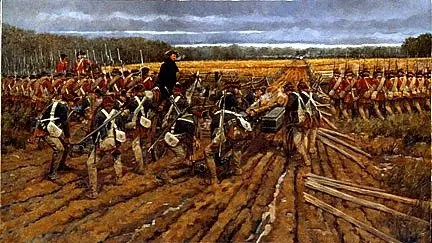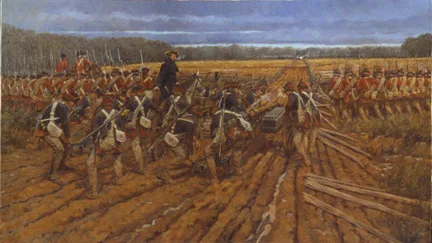Thursday, May 25, 2017
View of Breed's Hill after the battle c. 1775
Original water color by artist Thomas Davis in 1775. View at base of Breed' hill looking up hill. The redoubt and breastwork are illustrated. Remains of various fences scattered about field. By the officers and soldiers in foreground note plants suggesting wet ground. This is area where British guns were bogged down.
A brigade order in Boston said the men may cut their hats, in the manner the 4th have done. These soldiers hats suggest how that should look. As to the fellow sitting down under the shade of the tree to the left he could be a light infantryman.
https://digitalcollections.nypl.org/items/96705235-c441-f877-e040-e00a18065df4
Sunday, May 14, 2017
Club game night
Last night was club game night. Ed and George invited me, and I was excited to go again. It had been a difficult night at work the night before (flight crews timed out and medical emergency so I did not leave work till after midnight) and it is always great fun to see and game with old friends.
As is usual there were three outstanding beautiful games. Mike put on a scaled down version of Trafalgar with Sails of glory. A great fun, and very beautiful game. Have to look into it more. Ralph staged a firefight of Cannane. Beautiful terrain and incredibly well done troops. A superb game as only Ralph can do. Both looked great and from the sounds of it all of the players had a great time.
I was fortunate to play in Ed's game of The Battle of Dybboll (May 28, 1849). The was during the First Schleswig-Holstein War 1848-49. Troops (Denmark, Prussian and German Federation) are all pretty much equal. The Prussians are not the army of the needlegun nor von Molkle. In fact they are quite average. It is a very colorful and evan fight, which historical Denmark won. The rules used were Volley and Bayonet. Ed put an incredible amount of work into this with amazing figure conversions and outstanding game devices to record losses and brigade status. Just really first rate!
For more on the game I would recommend you check out Ed's blog (Ed M's Wargame Meanderings) here http://edmwargamemeanderings.blogspot.com/2017/05/danish-delight-battle-of-dybbol-5-june.html
or AJ's blog for a write up of a game test here http://ajs-wargaming.blogspot.com/2017/05/battle-of-duppel-28-may-1849.html. Both will give a better understanding of the game then I can.
 |
| Prussian Hussars capture the battery |
 |
| Over running the Infantry |
 |
| Some of Ed's beautifully done troops. |
 |
| Prussian brigade advancing |
 |
| Fire fight while the Guards move towards the woods |
From my point of view the game was great fun. Bob's Dannish cavalry caused no end of damage and mischief, destroying George's artillery before they could come into action. I returned the favor by reenacting "von Bedlow's Death Ride" against Bob's artillery and infantry. Who said cavalry is useless! I managed to out flank the Dannish line through the woods with my guards brigade while my line held his attention. Alas, it was too little to late as the Dannish forces held on to win the game.
A great night was had by all! Beautiful painted figures, on excellent terrain and great camaraderie with friends. It does not get any better then this!
Cheers 🍺
Thursday, May 11, 2017
British Order of Battle Guilford Courthouse Campaign
British Southern Army: December 1780 to March 1781
Lieutenant General Lord Charles Cornwallis
Webster’s Brigade: Colonel James Webster
7th Regiment of Foot (24)
23rd Regiment of Foot. (30)
33rd Regiment of Foot. (30)
Brigade of Guards: General Charles O'Hara
Guards Light Infantry Company (12)
Guards Grenadier Company (12)
1st Guards Battalion (30)
2nd Guards Battalion (30)
Reserve Brigade: Major General Leslie
1st Bn/71st Highland Regiment (24)
2nd Bn/71st Highland Regiment (24)
von Bose Regiment (Trumbach) (30)
Unbrigaded:
British Light Infantry battalion (12)
Jaeger company (9)
Royal Artillery ( 6-pdr & 3-per)
British Legion: Lt. Colonel Banastre Tarelton
British Legion Dragoons
1st Squadron/British Legion Dragoons: (8)
2nd Squadron/British Legion Dragoons: (8)
3rd Squadron/British Legion Dragoons: (8)
British Legion Infantry (24)
British Legion Artillery (3-pdr)
17th Light Dragoon (6)
Camden Brigade:
Lt. Colonel Lord Rawdon
Royal North Carolina Regiment (30)
Volunteers of Ireland Regiment (30)
New York Volunteers Regiment (24)
South Carolina Royalist (24)
Coffin's Dragoons (6)
Camden District Loyalist Militia (30)
Royal Artillery (6 pdr)
Ninety-Six, South Carolina
Cruger's Loyalist Brigade:
Lieutenant Colonel John Harris Cruger
1st Bn/Delancey's (18)
3rd Bn/New Jersey Volunteers (24)
South Carolina Royalists (30)
Loyalist Artillery (2 x 3-pdr)
96th District South Carolina Loyalist Militia Brigade:
Brigadier Robert Cunningham
King's Long Cane Loyalist Militia (24)
Cunningham's Little River Loyalist Militia (24)
Stevens Creek Loyalist Militia (24)
Dunlap's Loyalist Dragoons (6)
Note: For March into North Carolina against Greene's army Cornwalis may take with him Webster's Brigade, Guard's brigade, Reserve Brigade, British Legion , unbrigaded troops and North Carolina Loyalist regiment.
Wednesday, May 10, 2017
American Order of Battle Guilford Courthouse Campaign
The following are the troops available, each month for the American commander. Please note that the order of battle changes each month. This is due to reinforcements arriving, and militia enlistment ending so they are going home.
January 1781
Brigadier General Daniel Morgan
Continental Light Brigade:
Lieutenant Colonel John Eager Howard
Maryland/Delaware Light Battalion (30)
Triplett’s Virginia Battalion (24)
Washington's Dragoons (10)
Pickens' South Carolina Militia Brigade (3rd South Carolina Brigade of Militia):
Colonel Andrew Pickens
1st Spartan SC Militia Regt. (30)
2nd Spartan SC Militia Regt. (30)
McCall's State Dragoons (6)
Cunningham's Rifle Battalion (12) (mounted)
Sumter's South Carolina Partisan Brigade (@400) (1st S.C. Brigade of Militia):
BG Thomas Sumter
Left Wing/Sumter (mounted) 24)
Right Wing/Sumter (mounted) (24)
Hampton's South Carolina State Dragoons (6)
-------------------------------------------------------------------
February 1781
American Southern Army (division):
Major General Nathaniel Greene
Brigadier General Daniel Morgan
Singleton's Continental Artillery (2 guns and crew)
Continental Light Brigade:
Lieutenant Colonel John Eager Howard
Maryland/Delaware Light Battalion (30)
Militia battalion (24)
Rifle Battalion (12)
Virginia Continental Brigade (Brigadier-General Isaac Huger)
1st Virginia Regiment (Lieutenant-Colonel John Green) (30)
Maryland Continental Brigade (Colonel Otho Williams).
1st Maryland Regiment (Colonel John Gunby) (30)
2nd Maryland Regiment (Lieutenant-Colonel Benjamin Ford) (30)
Washington's Dragoons (10)
Lee's Legion (brigade)
Lee's Legion Dragoons (12)
Lee's Legion Infantry (12)
Stevens' Virginia Militia Brigade
Brigadier General Edward Stevens
Stevens' Virginia Militia (24)
North Carolina Militia Brigade (873)
Brigadier General William Davidson
William's Surrey County, North Carolina Militia Battalion (24)
Polk's Mecklenburg Militia Battalion (24)
Locke's Rowan County, N.C. Militia Battalion (24)
Graham's Mecklenburg County, N.C. Dragoons (6)
McDowell's North Carolina Riflemen (12) (mounted)
Winston's North Carolina Riflemen (mounted) (12)
Pickens' South Carolina Militia Brigade (3rd South Carolina Brigade of Militia):
Colonel Andrew Pickens
1st Spartan SC Militia Regt. (30)
2nd Spartan SC Militia Regt. (30)
McCall's State Dragoons (6)
Cunningham's Rifle Battalion (12) (mounted)
---------------------------------------------------------
March 1781
Virginia Continental Brigade (Brigadier-General Isaac Huger)
1st Virginia Regiment (Lieutenant-Colonel John Green) (30)
2nd Virginia Regiment (Lieutenant-Colonel Samuel Hawes) (30)
Maryland Continental Brigade (Colonel Otho Williams).
1st Maryland Regiment (Colonel John Gunby) (30)
2nd Maryland Regiment (Lieutenant-Colonel Benjamin Ford) (30)
Virginia Militia Brigade (Brigadier-General Edward Stevens).
2 battalions of 24 figures each
Virginia Militia Brigade (Brigadier-General Robert Lawson).
2 battalions of 30 each
North Carolina Militia Brigade (Brigadier-General John Butler).
1 battalion of 30
North Carolina Militia Brigade (Brigadier-General Thomas Eaton).
2 battalions of 30 each
Rifle Regiments
(one corps was led by Colonel William Campbell, another by Colonel Charles Lynch
2 battalions of 12 each
Light Dragoons and Partisan Corps:
Delaware Light company
12 figures
William Washington’s Light Dragoons:
8 Cavalry
Lee’s Legion:
9 Infantry
8 Cavalry
Continental Artillery (two 2-gun sections)
Tuesday, May 9, 2017
The Cowpens - Guilford Courthouse Campaign refought .
In volume one issue one of The Courier Steve Haller wrote an article about wargaming campaigns without maps. in this article he refought the Cowpens -Guildford Courthouse campaign using this method. Always a big fan of his writing in the Courier, I recently revisited his article with a mind to use his suggested campaign.
In his introduction Haller wrote, "War gamers who enjoy the variety that acampaign offers for the use of their collections are often discouraged by the time and clutter involved when maps are used. An alternative method might employ the use of an scenario based on a historical campaign (complete with OB's, etc) which allows elements of choice and chance to determine the nature of each battle of the campaign. Each battle is assigned a number of points that are awarded based on the results of the Battle (e.g. comparison of casualty ratios). " To me this has always been a fascinating idea which I wanted to try out. Taking Steve Haller's article and work I have slightly modified it by changing some of the options for battles and created my own order of battles based on historical returns. But the spirit of the campaign remained what Steve wrote way back in the early 1980's. Here is my outline and rules for the Cowpens -Guilford Courthouse Campaign. The campaign order of battle including militia desertion (i.e. going home) and reinforcements will be in the next post as part 2.
Campaign Guide Lines:
1. Rules used are Loose Files and American Scramble.
2. Figure scale is 10:1
3. Terrain to be based on historical battles in the area.
4. After each battle 25% of casualties will be returned to each unit. One month after that battle all American units (including loyalists) receive an additional 25% returned. Two months after battle British and Hessian units receive back 25% casualties. Units that drop to under 20% of their original strength after a battle are eliminated.
5. Staff Officers return after battle if roll a 4-6 on a D6.
6. Players should be familiar with the historical campaign.
THE CAMPAIGN:
1. January 1781
General Morgan invades South Carolina with his Light Troops. He can successfully link up with Pickens' South Carolina brigade by rolling 1-4 on a D6; Sumter's brigade will join on a roll of 1-3.
Morgan now has three options:
1. Fight Cowpens as the historical battle with historical order of battle.
2. Attack Camden. The garrison under Rawden will march out to fight him at the Hobkirk Hill area. After that battle Tarleton will try to intercept Morgan by rolling a 1-3 for an encounter battle.
3. Attack the Fort Ninety-Six garrison. A defense will be set up by Cruger based on a Steve Haller scenario. The garrison can be reinforced by Tarleton by rolling 1-4 on a turn determined by a die roll.
2. February 1781
Cornwallis' and Tarleton chase Greene's and Morgan's forces through North Carolina. The following battles are possible and determined by a die roll:
1. Cowen's Ford will be defended by Davidson's militia brigade as the historical battle by rolling 1-4. Greene can detach elements of the Continental Light Division to assist on a turn determined by a die roll.
2. A meeting engagement on random terrain involving all units if a 5-6 is rolled.
March 1781
Greene's reinforced army turns to fight Cornwallis army.
1. Guilford Courthouse as the historical battle by rolling 1-4.
2. Greene attacks Cornwallis army at Guilford Courthouse by rolling 5-6.
Victory is determined by casualties and condition of army at end of campaign. Forces available for certain battles or each month will be posted in addition order of battles.
I am presently finishing the last couple of regiments for this campaign. Once done I will be reporting the progress of how this turns out. I am looking to set this up for June 2017.
Subscribe to:
Posts (Atom)















